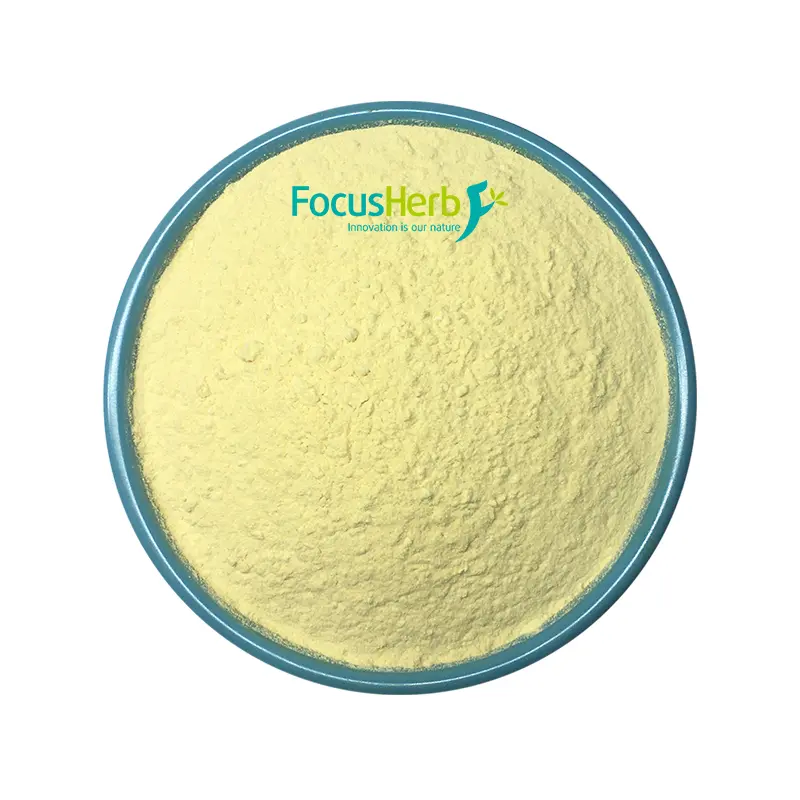Vitamin K1, also known as phylloquinone, is a fat-soluble vitamin chemically composed of a naphthoquinone ring and an unsaturated side chain containing multiple isoprene units. This unique molecular structure gives it its fat-soluble properties, making it readily soluble in fats and organic solvents but poorly soluble in water. In nature, vitamin K1 is widely found in the chloroplasts of green plants, with leafy greens such as spinach and kale being a rich dietary source.
In the body, vitamin K1 plays an essential role. As a coenzyme for γ-carboxylase, it is deeply involved in the synthesis of coagulation factors II (prothrombin), VII, IX, and X. In the liver, glutamic acid residues in coagulation factor precursors undergo γ-carboxylation to convert them into biologically active forms, thereby participating in the normal coagulation cascade. This ensures rapid clotting when blood vessels are damaged, preventing excessive bleeding. In addition to its key role in blood coagulation, vitamin K1 is also involved in physiological processes such as energy metabolism. Although its specific mechanisms are not yet fully understood, research suggests that it may be involved in intracellular electron transport and redox reactions, which is crucial for maintaining normal cellular physiological function.
Dual Regulator of Bone Health: From Traditional Perception to New Discoveries
Vitamin K1 has long been known to play a crucial role in the blood coagulation system. When the human body is injured and bleeding occurs, vitamin K1 helps activate coagulation factors, promoting the conversion of fibrinogen to fibrin, which in turn forms a blood clot and effectively stops the bleeding. However, recent research has expanded our understanding of vitamin K1’s functions, revealing its crucial role in bone health and establishing a dual regulatory model of “blood coagulation and bone metabolism.”
In bone metabolism, vitamin K1’s activation of osteocalcin is one of its core mechanisms for maintaining bone health. Osteocalcin is a non-collagenous protein synthesized and secreted by osteoblasts and is crucial for regulating bone mineralization and metabolic balance. Vitamin K1, as a coenzyme, participates in the γ-carboxylation reaction of glutamic acid residues in the osteocalcin molecule, converting osteocalcin from an inactive to an active state. Activated osteocalcin can specifically bind calcium ions, promoting the deposition of calcium salts on skeletal collagen fibers, enhancing bone mineralization and improving bone strength and toughness.
Vitamin K1 also regulates the dynamic balance between osteoblasts and osteoclasts. Osteoblasts are responsible for the synthesis and construction of new bone, while osteoclasts are responsible for the absorption and removal of old bone. Their synergistic effect maintains normal bone metabolism and renewal. Vitamin K1 can reduce bone resorption by inhibiting osteoclast activity. It also promotes osteoblast proliferation and differentiation, enhancing bone formation, thereby maintaining overall bone mass stability and preventing the development of bone diseases such as osteoporosis. Studies in postmenopausal women have found that vitamin K1 supplementation can significantly slow the decline in bone density and reduce the risk of fractures, further confirming its positive role in maintaining bone health.
Three Core Mechanisms of Vitamin K1 in Maintaining Bone Health
(I) Promoting Osteocalcin Activation and Calcium-Phosphorus Deposition
In the microscopic world of bone metabolism, vitamin K1 acts like a sophisticated “molecular engineer,” directing the critical processes of osteocalcin activation and calcium-phosphorus deposition. Osteocalcin, the product of the diligent work of osteoblasts, is initially weakly active, like an unpolished jade. Vitamin K1, however, is the indispensable “master carver.” As a coenzyme for γ-glutamyl carboxylase, its unique molecular structure allows it to precisely recognize the glutamic acid residues within the osteocalcin molecule. Through a complex and orderly series of enzymatic reactions, vitamin K1 promotes the carboxylation of glutamic acid residues 17, 21, and 24.
This carboxylation process acts as a “magic key” for osteocalcin, awakening it from its inactive “dormant state” and transforming it into an active form with potent calcium-binding capacity. Activated osteocalcin, like a navigation system, can specifically recognize and tightly bind to hydroxyapatite, the core “building block” of bone mineralization. This binding creates a stable “home” for calcium salts, attracting a steady stream of calcium ions from the blood to be deposited into the bone matrix. With this continuous accumulation of calcium salts, bone density gradually increases, much like the continuous addition of bricks to a high-rise building. Its mechanical strength also significantly increases, allowing it to better withstand the stresses of daily activities and effectively reduce the risk of fractures.
Clinical studies have also provided strong evidence for this crucial role of vitamin K1. A long-term follow-up study of a large number of osteoporosis patients found that for every 10% increase in carboxylated osteocalcin levels, the patients’ fracture risk decreased by 15%. This data clearly demonstrates the positive impact of vitamin K1 on bone health by promoting osteocalcin activation, highlighting its crucial role in preventing fractures and maintaining bone strength.
(II) Regulating the Dynamic Balance between Osteoblasts and Osteoclasts
Bone is not a static structure; rather, it is in a dynamic equilibrium of constant renewal and remodeling. This process relies on the coordinated action of osteoblasts and osteoclasts. In this delicate “bone symphony,” vitamin K1 plays a crucial “conductor” role, precisely regulating the activity of osteoblasts and osteoclasts to maintain stable bone metabolism.
Vitamin K1 subtly activates the Wnt/β-catenin signaling pathway, which acts like an intracellular “superhighway,” transmitting vital instructions for promoting cell differentiation and proliferation. In bone tissue, when the Wnt/β-catenin signaling pathway is activated, osteoblasts, like receiving a rally call, accelerate their differentiation, gradually transforming from a primitive stem cell state into mature cells with robust bone-building capacity. These newly formed osteoblasts actively synthesize collagen and other bone matrix components, like diligent craftsmen constantly adding new building materials to the skeletal edifice, laying a solid foundation for subsequent calcium deposition. Vitamin K1 also plays a crucial role in regulating osteoclasts. Receptor activator of nuclear factor κB ligand (RANKL) is a key signaling molecule for osteoclast maturation and activation, acting as the “start button” for osteoclasts. Vitamin K1 inhibits RANKL-mediated osteoclast maturation, acting like a “brake” on osteoclast activation and reducing excessive bone resorption. Through this bidirectional regulatory mechanism, vitamin K1 maintains a balance between bone formation and bone resorption, preventing excessive bone loss or abnormal bone gain.
In postmenopausal women, the sharp decline in estrogen levels disrupts the normal balance of bone metabolism, leading to increased osteoclast activity and accelerated bone resorption, resulting in an annual bone loss rate of 0.3% to 0.5%. Vitamin K1 supplementation can effectively alleviate this phenomenon by regulating the dynamic balance between osteoblasts and osteoclasts, slowing bone loss, maintaining bone health, and reducing the risk of postmenopausal osteoporosis.
(III) Synergizing with Calcium Supplements to Improve Calcium Utilization Efficiency
Among the nutritional forces that maintain bone health, calcium supplements are undoubtedly the primary force in providing bone “building materials,” while vitamin K1 acts as a wise “navigator.” Working together, the two achieve optimal results. When calcium supplements alone are taken, blood calcium concentrations rapidly rise. However, this calcium, like a lost “wanderer,” struggles to be accurately deposited in bones. Instead, it may accumulate abnormally in blood vessels and soft tissues, increasing health risks such as vascular calcification and kidney stones.
At this point, vitamin K1 steps in, leveraging its unique physiological function to provide direction for calcium transport. It interacts with calcium-binding proteins, guiding calcium ions across numerous cellular barriers for targeted deposition in bone tissue. This process acts like a precise “map” for calcium, ensuring its smooth arrival in bones, where it participates in bone mineralization and repair, enhancing bone strength and toughness.
Clinical trial data strongly demonstrates the advantages of the synergistic effect of vitamin K1 and calcium supplements. A comparative study divided subjects into two groups: one receiving calcium supplementation alone and the other receiving calcium supplementation combined with vitamin K1. Over time, the group taking calcium and vitamin K1 supplements showed a 22% increase in annual lumbar spine bone density compared to the calcium-only group. This suggests that combined supplementation more effectively promotes calcium absorption and utilization by bones, increasing bone density. Urinary calcium excretion decreased by 18% in the combined group, indicating that more calcium was retained in the body for bone building rather than lost, significantly improving calcium metabolism and further highlighting the important role of vitamin K1 in synergizing with calcium supplements to maintain bone health.
Potential Threats of Vitamin K1 Deficiency to Bone Health
(I) Bone Damage Risk in Different Populations
Vitamin K1 deficiency poses varying degrees of threat to bone health in different age groups, from the growth and development of children and adolescents to bone degeneration in middle-aged and elderly individuals, affecting individuals throughout life.
During the prime growth period of children and adolescents, vitamin K1 deficiency acts like a hidden time bomb, seriously threatening normal bone development. Osteocalcin plays a key role in bone growth and shaping during this period, and vitamin K1 deficiency leads to insufficient carboxylation of osteocalcin, preventing it from fully promoting bone mineralization. During epiphyseal development, children with vitamin K1 deficiency experience inhibited proliferation and differentiation of epiphyseal chondrocytes, resulting in sparse trabeculae, similar to the loosening of steel reinforcement in a building. Cortical bone also gradually thins, similar to the weakening of a building’s exterior wall. Alarming epidemiological data show that children with insufficient vitamin K1 intake have a 35% higher incidence of lower limb long bone fractures than those with adequate intake. During the rapid growth period before puberty, children are active and lively, placing significant strain on their bones. A vitamin K1 deficiency during this period makes it difficult for bones to withstand the stresses of daily activities. A single misstep can lead to fractures, severely harming children’s physical and mental health.
With increasing age, middle-aged and elderly individuals also face the severe challenge of vitamin K1 deficiency. As we enter middle age and old age, our body’s functions gradually decline, and the efficiency of vitamin K1 absorption decreases by 30%-40%. Like an aging machine, its ability to absorb nutrients is significantly weakened. This directly leads to decreased levels of carboxylated osteocalcin, hindering bone mineralization and causing a continuous decrease in bone density, exacerbating the progression of osteoporosis. According to statistics, the rate of vitamin K1 deficiency in people over 65 is as high as 25%, and the incidence of hip fractures in these individuals is 2.3 times higher than in those with sufficient vitamin K1. In daily life, seemingly trivial actions, such as slips and minor collisions, can trigger hip fractures in middle-aged and elderly individuals with vitamin K1 deficiency. Hip fractures often lead to long-term mobility impairment, severely impacting quality of life, and even potentially leading to a series of life-threatening complications.
(II) Pathological Mechanisms and Clinical Manifestations
Long-term vitamin K1 deficiency triggers a series of complex and dangerous pathological changes in the body, with the accumulation of uncarboxylated osteocalcin (ucOC) being a key component. Under normal physiological conditions, osteocalcin undergoes carboxylation with the assistance of vitamin K1, exerting its positive effects on bone. However, when vitamin K1 is deficient, osteocalcin cannot undergo normal carboxylation, and ucOC begins to accumulate in the body. ucOC acts as a disruptor in bone metabolism, and its accumulation can disrupt the balance of bone metabolism. Studies have shown that for every 1SD increase in ucOC, bone turnover increases by 12%, disrupting the normal rhythm of bone renewal and the dynamic balance between bone resorption and formation. Under the influence of UCOC, bone microstructure is severely damaged, increasing the risk by 20%. Once orderly, orderly trabeculae become disorganized and fractured, and the cortical bone gradually thins, leaving the overall structure of the skeleton fragile, like a crumbling building.
These pathological changes are clinically evident and painful. Patients often experience bone pain, which can be persistent and dull or worsen with activity, severely impacting daily life. Shortening of height is also a common symptom. Due to osteoporosis and compression deformation of the vertebrae, patients gradually lose height and develop a hunched posture. Further aggravation of spinal deformation leads to significant changes in posture, not only affecting appearance but also compressing cardiopulmonary function, leading to a range of health problems such as difficulty breathing. The most serious consequence is brittle fractures, which often occur with minimal force. Even seemingly ordinary actions like coughing and sneezing can cause vertebral compression fractures, causing significant pain and damage to patients, severely reducing their quality of life, and even threatening their health.
Practical Strategies for Scientific Vitamin K1 Supplementation
(I) Dietary Sources and Efficient Absorption
Dark green vegetables are undoubtedly a vitamin K1 gold mine in our daily diet. Spinach is a standout, with a whopping 482μg of vitamin K1 per 100g. Chinese kale also boasts a significant 440μg per 100g. These dark green vegetables are not only rich in vitamin K1 but also in a variety of other nutrients. For example, the iron in spinach plays a positive role in preventing iron-deficiency anemia, while the dietary fiber in Chinese kale helps promote intestinal motility and maintain intestinal health. In addition to dark green vegetables, vegetable oils are also a significant source of vitamin K1. Olive oil, for example, contains 14μg per 10g. Fermented foods, such as sauerkraut and kimchi, increase their vitamin K1 content through the action of microorganisms during the fermentation process, providing another avenue for us to obtain vitamin K1. To meet the body’s physiological needs for vitamin K1, a daily intake of 45-65μg is recommended. When consuming foods rich in vitamin K1, cleverly utilizing its fat-soluble properties can significantly improve absorption. Combining vitamin K1 with fat-rich foods is a good option. For example, pairing a spinach salad with some nuts can boost vitamin K1 absorption by 40%-60%. Avocado is also a great accompaniment. Mixing avocado with leafy greens in a salad offers both a delicious flavor and enhanced vitamin K1 absorption. It’s important to note that consuming foods rich in vitamin K1 on an empty stomach is best avoided, as insufficient bile secretion can hinder vitamin K1 absorption, much like a machine operating without lubricant.
(II) Suitable Populations and Dosage Specifications for Vitamin K1 Supplements
For some special populations, dietary supplementation alone may not be enough to meet the body’s vitamin K1 needs. Therefore, supplementation with supplements is particularly important. Vegetarians, due to their dietary habits and relatively limited food sources, are prone to vitamin K1 insufficiency. Patients with hepatobiliary diseases, such as cholecystitis and hepatitis, have impaired liver metabolism and absorption of vitamin K1. Even if they consume sufficient vitamin K1, it is difficult for the body to effectively utilize it. For those who take broad-spectrum antibiotics for a long time, while antibiotics kill harmful bacteria, they also destroy beneficial intestinal bacteria, leading to intestinal dysbiosis and impairing vitamin K1 synthesis and absorption. People at high risk of osteoporosis, such as postmenopausal women and the elderly, experience a negative balance in bone metabolism and require additional vitamin K1 to maintain bone health and prevent the development of osteoporosis.
For these individuals, a daily supplement of 20-50μg of vitamin K1 preparations is recommended. When using supplements, it is important to strictly adhere to safety limits. The upper limit of vitamin K1 tolerance for adults is 1mg/day; excessive supplementation can cause a series of adverse reactions. One such issue is red blood cell hemolysis. Excessive vitamin K1 can damage the cell membrane structure of red blood cells, causing them to rupture and impairing oxygen transport and supply. It can also interfere with the efficacy of anticoagulant medications such as warfarin. Warfarin works by inhibiting the synthesis of vitamin K-dependent coagulation factors. Excessive vitamin K1 can counteract warfarin’s effectiveness and increase the risk of thrombosis. Therefore, before taking vitamin K1 supplements, consult a doctor and follow their professional guidance to ensure safety and effectiveness.
(III) Synergistic Combinations with Other Nutrients
In the journey of maintaining bone health, vitamin K1 doesn’t work alone; it can be even more effective when used in synergy with other nutrients. Vitamin D3 is one of vitamin K1’s best allies; taking them together provides a double insurance policy for bone health. Vitamin D3 promotes intestinal calcium absorption, bringing more calcium into the body. Vitamin K1, on the other hand, guides calcium deposition into the bones, preventing abnormal accumulation in blood vessels, soft tissues, and other areas. When supplementing with vitamin K1 and vitamin D3, the recommended daily intake of vitamin D3 is 400-800 IU. In a clinical study of elderly individuals, the combined supplementation group achieved a 30% greater increase in bone density compared to the group receiving either vitamin K1 or vitamin D3 alone, strongly demonstrating the synergistic benefits of the two.
Magnesium supplements also effectively complement vitamin K1 in maintaining bone health. Magnesium activates multiple enzymes in the body and is crucial for maintaining the function of the calcium pump. The calcium pump acts as a bridge, transporting calcium from the blood into bone cells. When magnesium is sufficient, the calcium pump operates efficiently, ensuring smooth calcium uptake into bones and strengthening bone strength. A daily intake of 300mg of magnesium is recommended. The “K-D-Mg” triangle combination formed by vitamin K1, vitamin D3 and magnesium has been verified in clinical practice. This program can increase the efficiency of bone density improvement by 30%, providing all-round, multi-level care for bone health.
 Cutting-Edge Research and Future Outlook
Cutting-Edge Research and Future Outlook
(I) In-Depth Analysis of Molecular Mechanisms
With the rapid advancement of science and technology, research into the molecular mechanisms by which vitamin K1 maintains bone health continues to deepen, opening a new window of understanding. Recent single-cell sequencing studies, like a precise scalpel, penetrate the microscopic world of cells, revealing the critical role of vitamin K1 in epigenetic regulation. Studies have found that vitamin K1 precisely regulates the aging process of osteoblasts through epigenetic modifications. Like a sophisticated “gene regulator,” it upregulates the expression of the SIRT6 gene. SIRT6, like the “youth code” within cells, effectively slows telomere shortening. Telomere stability is crucial for maintaining cell vitality and normal function. In this process, vitamin K1 provides a new target for anti-aging bone maintenance, providing a deeper understanding and new research directions for delaying bone aging and preventing diseases such as osteoporosis.
Vitamin K1 has also demonstrated remarkable performance in animal experiments. Researchers conducted a continuous vitamin K1 supplementation experiment on elderly mice and surprisingly found that their bone condition significantly improved. The number of trabeculae increased by 25%, like adding more supporting beams to the skeleton, making the bone structure more stable. Microcracks decreased by 40%, effectively reducing bone fragility and significantly improving bone quality and strength. These results not only provide strong evidence for the role of vitamin K1 in bone health, but also lay a solid foundation for the development of more effective bone health maintenance strategies.
(II) Public Health Intervention Recommendations
From a public health perspective, the role of vitamin K1 in maintaining bone health cannot be ignored. Currently, the average daily vitamin K1 intake in my country is only 32μg, far below the World Health Organization’s recommended 45μg. This is a worrying situation. To improve this situation, a series of practical intervention measures are needed.
Including dark green vegetable intake in osteoporosis screening is an important measure. As a high-quality source of vitamin K1, dark green vegetable intake can directly reflect the body’s vitamin K1 intake. By incorporating this into screening criteria, we can more comprehensively assess individual bone health risks and promptly identify potential problems. Integrating serum ucOC testing with personalized supplementation guidance is also a key step. Serum ucOC levels are a key indicator of vitamin K1 nutritional status and bone health. By testing ucOC, we can accurately determine an individual’s vitamin K1 deficiency, enabling personalized supplementation recommendations and targeted intervention.
Establishing a three-tiered prevention and control system—”dietary assessment – biochemical testing – targeted intervention”—is a core strategy for maintaining bone health from a public health perspective. Dietary assessment helps us understand residents’ daily diets and identify those with insufficient vitamin K1 intake. Biochemical testing provides scientific data to clarify individual vitamin K1 nutritional status. Targeted intervention uses assessment and testing results to develop targeted supplementation plans and health guidance for different populations. This system enables early detection and intervention of bone health issues, effectively reducing the incidence of diseases like osteoporosis and improving overall bone health. Vitamin K1, the silent guardian of bone health, plays a role far beyond its traditional coagulation function. By activating osteocalcin carboxylation, regulating bone metabolism, and facilitating calcium utilization, vitamin K1 provides a multifaceted bone protection strategy for people of all ages. With in-depth research on its molecular mechanisms and innovative application technologies, this nutrient is expected to play an even more crucial role in the prevention and treatment of osteoporosis, advancing the concept from “calcium supplementation” to “holistic regulation of bone metabolism.”






















 Cutting-Edge Research and Future Outlook
Cutting-Edge Research and Future Outlook